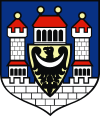| Revision as of 14:24, 7 March 2007 editBundesamt (talk | contribs)729 editsm disambiguation link repair (You can help!)← Previous edit | Revision as of 19:58, 7 March 2007 edit undoSpace Cadet (talk | contribs)8,095 editsNo edit summaryNext edit → | ||
| Line 4: | Line 4: | ||
| It was first mentioned as ''Crosno'' in 1005 and was chartered as a town in 1201. Due to its important strategic location the town played an important role in the protective system at the western borders of Poland during the 11th to 13th centuries. A stone castle was built by the ] in the 13th century. The duchess of Silesia ] took refuge in it during the Mongol attacks. The town changed hands several times, once it went as payment to Brandenburg soldiers. | It was first mentioned as ''Crosno'' in 1005 and was chartered as a town in 1201. Due to its important strategic location the town played an important role in the protective system at the western borders of Poland during the 11th to 13th centuries. A stone castle was built by the ] in the 13th century. The duchess of Silesia ] took refuge in it during the Mongol attacks. The town changed hands several times, once it went as payment to Brandenburg soldiers. | ||
| When the Silesian ] ] died in 1476, his widow ], daughter of ] ] ], inherited the territory of |
When the Silesian ] ] died in 1476, his widow ], daughter of ] ] ], inherited the territory of Krosno, while the area was part of ]n lien in 1482. Several claims ended when the emperor ] renounced all rights to Krosno in 1538, thereby finalising the Krosno district's belonging to Brandenburg. Since then the Brandenburg, later Brandenburg-Prussia and Prussia ] electors held the title, duke of Silesia and showed the black Silesian eagle along with other states belonging to Brandenburg. | ||
| The emperors held on to further Silesian territory, also inherited by Brandenburg, until in 1742 that became part of Brandenburg-Prussia as well. The Crossen district was part of ] and Germany as |
The emperors held on to further Silesian territory, also inherited by Brandenburg, until in 1742 that became part of Brandenburg-Prussia as well. The Crossen district was part of ] (since 1740) and Germany (since 1871) as ] and remained so until 1945, when it was conquered by Soviet Union and returned to Poland. | ||
| Today, Krosno Odrzańskie is the capital of the Krośnieński district. | Today, Krosno Odrzańskie is the capital of the Krośnieński district. | ||
Revision as of 19:58, 7 March 2007

Krosno Odrzańskie (Template:Lang-de) is a city in Western Poland with 12,500 inhabitants (2002), situated in the Lubusz Voivodeship (since 1999), previously part of Zielona Góra Voivodeship (1975-1998). It is the capital of Krosno County. (Note: Do not confuse this with Krosno in the Subcarpathian Voivodeship.)
It was first mentioned as Crosno in 1005 and was chartered as a town in 1201. Due to its important strategic location the town played an important role in the protective system at the western borders of Poland during the 11th to 13th centuries. A stone castle was built by the Silesian Piasts in the 13th century. The duchess of Silesia Hedwig of Andechs took refuge in it during the Mongol attacks. The town changed hands several times, once it went as payment to Brandenburg soldiers.
When the Silesian Piast Henry of Głogów died in 1476, his widow Barbara von Brandenburg, daughter of Brandenburg Elector Albert Achilles, inherited the territory of Krosno, while the area was part of Bohemian lien in 1482. Several claims ended when the emperor Ferdinand I renounced all rights to Krosno in 1538, thereby finalising the Krosno district's belonging to Brandenburg. Since then the Brandenburg, later Brandenburg-Prussia and Prussia Hohenzollern electors held the title, duke of Silesia and showed the black Silesian eagle along with other states belonging to Brandenburg.
The emperors held on to further Silesian territory, also inherited by Brandenburg, until in 1742 that became part of Brandenburg-Prussia as well. The Crossen district was part of Prussia (since 1740) and Germany (since 1871) as Lower Silesia and remained so until 1945, when it was conquered by Soviet Union and returned to Poland.
Today, Krosno Odrzańskie is the capital of the Krośnieński district.
Famous People
- Georg Wenzeslaus von Knobelsdorff (1699-1753) painter and architect
- Johann Friedrich Schönemann (1704-1782), theater director
- Rudolf Pannwitz (1881-1969), author
- Hans Egidi (1890-1976), former president of court
- Alfred Henschke ps.Klabund (1890-1928), author
- Tomasz Kuszczak - Poland national football team
- Aneta Pastuszka - Olympic canoer
External links
- 1615 Map of Brandenburg with Duchy of Crossen on Oder river
- Official town website
- Map via mapa.szukacz.pl

This Lubusz Voivodeship location article is a stub. You can help Misplaced Pages by expanding it. |
52°03′N 15°05′E / 52.050°N 15.083°E / 52.050; 15.083
Categories: